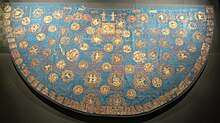Star mantle of Henry II.
The starry cloak of Henry II is an important work of medieval textile art . The coat exhibited today in the Diocesan Museum of Bamberg was a gift from the Apulian prince Meles von Bari to Henry II on the occasion of the emperor's meeting with Pope Benedict VIII in Bamberg in 1020 .
description
The image of the program with gold embroidery formally strewn vestments the attached at the bottom left inscription can be seen: it is a description of the whole Erdkreises (descriptio TOCIVS ORBIS). A Majestas Domini - applique with that in the Mandorla enthroned Christ surrounded by the four beasts of the Apocalypse , occupies the most prominent location in the center of the upper mantle back. Christ is flanked by Sol - the personified sun -, Luna - the moon -, a cherub , a seraph, as well as Alpha and Omega , the first and last letters of the Greek alphabet as symbols for the beginning and end of the world. The world, which is completely subordinate to Christ, is represented by Mary , the Mother of God , John the Baptist , two holy bishops and six nimbly seated figures, while the zodiac signs and the two hemispheres stand for the entire universe. The numerous, highly elaborate representations are each surrounded by also embroidered aphorisms, which partially incorrect to Latin translated Phainomena ( celestial phenomena ) of Aratos , one in the third century. Didactic poem originated in BC , served as a template. An inscription on the right side names the founder of the work: PAX ISMAHELI QVI HOC ORDINAVIT (Peace to Ismahel, who commissioned this).
background
The founder name Ishmael is a pseudonym to look for Meles of Bari, who, after the Battle of Cannae in 1018 by the Byzantines had been defeated, Henry assistance requested and in 1020 traveled to Bamberg, where Pope Benedict VIII. At Easter the Kaiser met to ask him for help in the fight against the expansion of the Byzantines in southern Italy. On this occasion, the prince wanted to present the coat to Heinrich as a present, but this was no longer possible because he passed away in Bamberg on April 23 of the same year before it was finished. This becomes clear through the embroidered wish for peace for the deceased. That Meles (Ismahel) intended the cloak for the emperor is shown by the dedication inscription on the lower hem : O DECVS EVROPAE CESAR HEINRICE BEARE | ANGEAT [= AVGEAT] IMPERIVM TIBI REX QVI REGNAT IN EVUM ( Hail to you, you adornment of Europe, Emperor Heinrich, your kingdom may be increased by the king who rules forever ). But Heinrich ultimately refused to wear the cloak and instead donated it to Bamberg Cathedral , after he had another inscription embroidered under the Christ Square with the wish for divine pleasure: SVP [ER] NE VSYE SIT GRATV [M] HOC CESARIS DONVM (May this imperial gift be welcome to the highest being).
classification
The rather elaborate embroidery, executed using the lay-on technique, was made around 1018-1024 in Regensburg . In contrast, the carrier material is a silk fabric from Italy from the period between 1453 and 1455, in which the coat was restored. The embroidery was cut out and sewn onto the new fabric. The original coat fabric , which is partially still present today under the appliqués, consisted of dark purple- violet silk.
literature
- Renate Baumgärtel-Fleischmann : The starry cloak of Emperor Heinrich II and its inscriptions. In: Walter Koch (Hrsg.): Epigraphik 1988. Specialist conference for medieval and modern epigraphy. Graz 10-14 May 1988. Verlag der Österreichischen Akademie der Wissenschaften, Vienna 1990, ISBN 3-7001-1790-6 , pp. 105–125.
- Renate Baumgärtel-Fleischmann: The imperial coats in the Bamberg cathedral treasure. In: Report of the Historisches Verein Bamberg 133, 1997, pp. 93–126.
- Horst Enzensberger : Bamberg and Apulia. In: Christine and Klaus van Eickels (eds.): The Bamberg diocese in the world of the Middle Ages. Lectures of the lecture series of the Center for Medieval Studies at the Otto-Friedrich-Universität Bamberg in the summer semester 2007. University of Bamberg Press, Bamberg 2007, ISBN 978-3-923507-28-3 , pp. 141–150 ( full text ).
- Norbert Jung , Wolfgang F. Reddig (ed.): Towards the sky. 1000 years of the Bamberg Cathedral 1012–2012. Catalog of the special exhibition (= publications of the Diözesanmuseum Bamberg. Volume 22). Michael Imhof Verlag, Petersberg 2012, ISBN 978-3-86568-754-8 , pp. 288-289 (with further literature).
- Wilhelm Messerer : The Bamberg Cathedral Treasure in its holdings until the end of the Hohenstaufen period. Hirmer, Munich 1952, pp. 54–57, plates 49–50.
- Wolfgang Metzger: The starry cloak of Emperor Heinrich II. In: Dieter Blume, Mechthild Haffner, Wolfgang Metzger: Constellations of the Middle Ages. The painted sky between science and imagination. Volume 1: 800-1200. de Gruyter, Berlin 2012, pp. 153–157 ( limited preview on Google Books ).
- Rudolf Schieffer : The star mantle of Emperor Heinrich II. In: Katharina Weigand, Jörg Zedler (Hrsg.): A museum of Bavarian history. Herbert Utz Verlag, Munich 2015, ISBN 978-3-8316-4200-7 , pp. 89-105.
- Percy Ernst Schramm , Florentine Mütherich : Monuments of the German kings and emperors . Volume 1, 2nd supplementary edition, Munich 1981, p. 163 (No. 130).
Web links
- Star mantle of Emperor Heinrich II on the pages of the House of Bavarian History .
- Star mantle in: Under the starry sky. 1000 years of the Bamberg diocese. 1007-2007. Online project of the Archdiocese of Bamberg .
- Star coat of Emperor Heinrich * II. (PDF) - detailed description on the website of the Archdiocese of Bamberg.
- Bamberg and Apulia - Against the prevailing doctrine on the origin of the starry mantle - Web version of a critical lecture in the 2007 lecture series: The Bamberg Diocese in the Middle Ages by Horst Enzensberger

